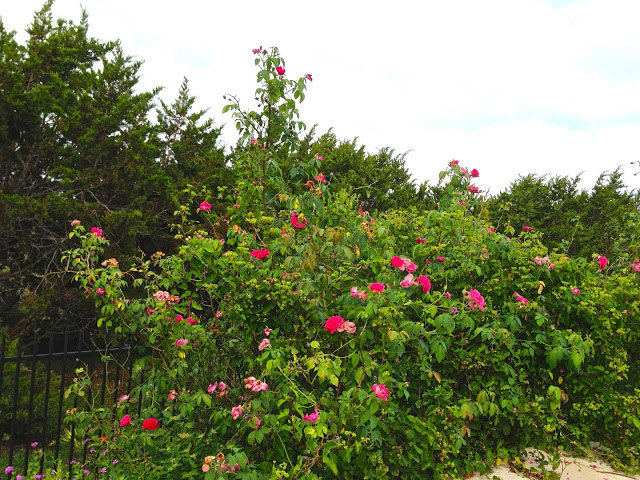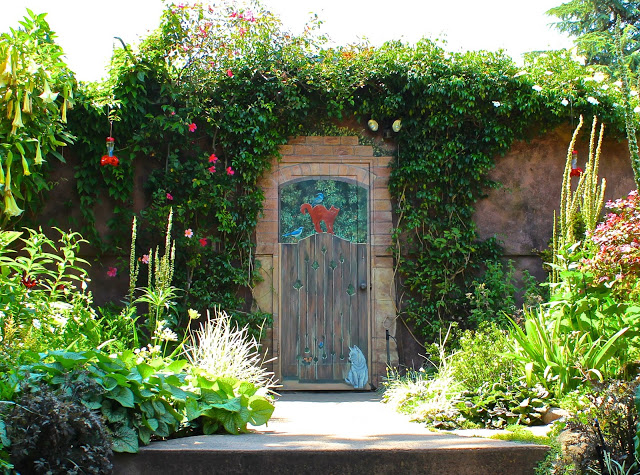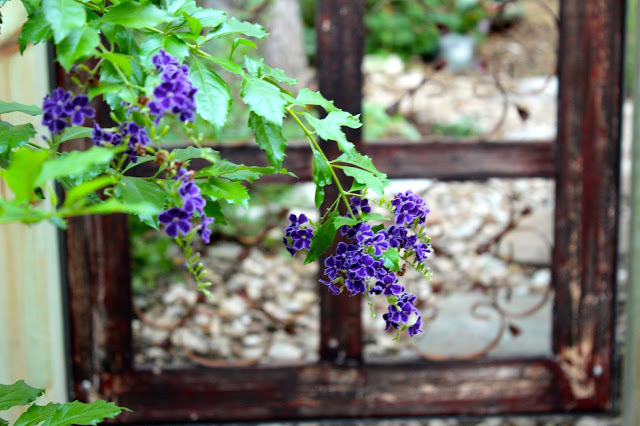Stunning San Francisco Fling garden tour of my dream garden…
The San Francisco Garden Bloggers Fling was an amazing adventure into a myriad of unique and beautiful gardens and micro climates. I expected the weather in San Francisco to be cool and comfortable. Not so. As is often the case when I’ve traveled to the annual garden flings, they were having an uncharacteristic heat wave. (The Texas bloggers have a theory that we bring the beat with us – a tradition we’d love to put an end to!)
San Francisco was tolerable, though as we ventured further out from the city, it was hotter (103 one day walking through the gardens) and drier. Of course the beauty of the micro climates is that it enabled us to tour a wonderful variety of gardens, all within driving distance.
On the last day, we visited the Ann Nichols Garden in Oakland. This was my favorite garden by far, filled with mysterious paths, babbling water features, unique artwork and an intricate garden of tropical plants and desert plants mixed with traditional plants. (I have a soft spot for tropicals and I garden in the scorching heat of the southwest in Austin, Texas.)
As you arrive, the garden rises from the street in a succulent-lovers hillside of hot with the tropical colors of agaves, yuccas, phormium and cannas.
Everyone ooohed and ahhhhed over this intricate spiral agave. It can’t take our arid heat, so I won’t be searching for one to plant in my garden.
I finally tore myself away from the hillside to follow a delicate, almost-hidden path up to the house. Lined with papyrus, aloes, ground cover and cannas, it led me to my ultimate destination — a stunning brugmansia, its bell-shaped blooms dripping over the path to envelop garden visitors in an apricot canopy.
Winding on the other side of the house is another path, filled with ground cover, succulents and grasses, that leads you up into the back garden.

Along the property line is a fence/trellis/jungle creation that hosts bromeliads, tillandsias ferns and other exotic
But unlike so many side gardens that are just an avenue for reaching another area, this was a mystical garden of its own. Flanked by layers upon layers of plants, the steps lead through a series of unique, artistic ponds that are part of a larger waterway system and all connected.
Here’s a garden blogger capturing a photo in the garden…you’ll laugh at this one. I was trying to remember who this was and I remember that I was wearing a peach blouse that day, wondering who else did. Then I realize this is a mirror that was hanging on the fence and that’s ME in the picture! Working on a creative photo shot, I captured myself and then promptly forgot about it. In any case, the mirror, tucked behind a treasure trove of plants, was a delightful find for garden visitors.
Next to the gate at the top of the stone steps, a tile mural covers the wall as a backdrop for the pond. Notice the cat in the mural – you’ll see him again in more art in the back garden.
Now onto the back garden. There are 3 levels in the back garden. Through the gate and continuing up the stairs, you pass another water feature as you’re drawn to another gate.
But wait, that’s a door, or is it. No, it’s a gate… It’s a door to a building, painted to look like the gate, with our friend the cat perched on top and his friend waiting for him at the bottom. So clever and entertaining. (And there’s another brugmansia to the left…sigh…)
And then it’s off to the right and up another set of steps, flanked by glorious loropetalums in pots, and up onto the small patch of lawn. In this lush setting, the grass itself is a focal point.
It was also a perfect gathering spot for the garden bloggers to share their thoughts on this amazing garden. Ann Nichols even invited a few of us inside the house to view the back garden from upstairs, which is the perch from which I shot this photo.
The back of the house is flanked by a lower-level patio area, filled with pots of suculents and a rock lined retaining wall filled with hot colors and wonderful textures.
You can see why I fell in love with this garden. I’m sure I could have spent the entire day there and still not seen everything it has to offer,
August Tip: Give Your Garden Scents Appeal
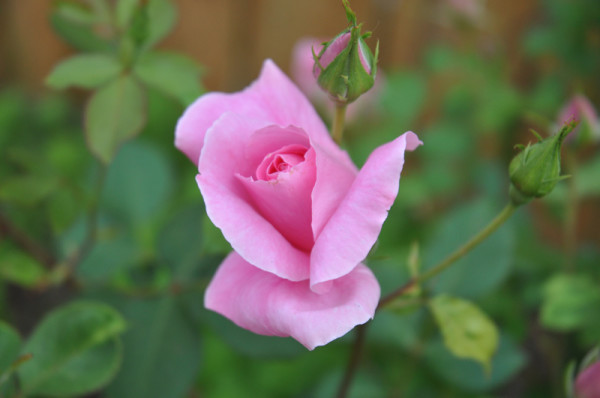
Sure, people may sometimes remind you to, “stop and smell the roses”, but sensory gardening is designed to stimulate more than just your vision or sense of smell. Sensory gardening aims to stimulate all of our senses; inviting us to touch, smell, hear and taste our natural surroundings as well.
Close your eyes, and consider all the elements you can take in throughout your landscape.There are lots of great suggestions for your sensory garden here.
Gardening for the senses

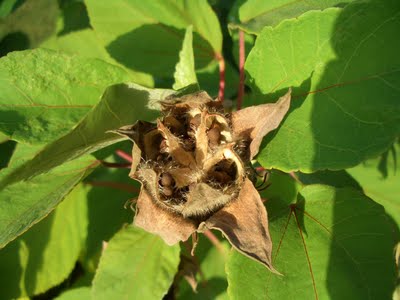 Sensory gardening is designed to stimulate all of our senses and enable us to not only see, in the garden, but also to touch, smell, hear and taste our natural surroundings.
Sensory gardening is designed to stimulate all of our senses and enable us to not only see, in the garden, but also to touch, smell, hear and taste our natural surroundings.
Beauty isn’t just in the eye of the beholder; it can surround us in the garden, titillating our other four senses as well.
Close your eyes, and consider all the elements you can take in throughout your landscape.
Scent
Roses might be the first plant that comes to mind when you think of creating a garden space that focuses on scents. Old-fashioned roses have infused gardens with their heady aromas for generations. Many other plants can also perfume your garden – to envelop you while sitting with a book in a garden room, or to waft up as you pass down a garden path. I love it when my dogs have been romping around in the rosemary – it’s so much more pleasant than when they just smell like dog.
If you like to entertain in the evenings, datura, a night-blooming plant also commonly known as angel’s trumpet, releases a sweet scent at dusk as it begins to open its flowers. Also fragrant at night are nicotiana, or tobacco plant and moonflower.
Many other trees, shrubs, perennials and annuals like those listed below can bring beautiful scents into your landscape.
- Mock orange
- Sweet almond verbena
- Lavender
- Artemesia
- Santolina
- Texas mountain laurel
- Clematis, honeysuckle, wisteria & star jasmine vines
- Sweetpea
- Chocolate cosmos
- Sweet Alyssum
- Herbs, Lemon and mint varieties in particular
- Rosemary
Small fragrant herbs like creeping thyme or chamomile can serve as groundcovers along paths or between pavers or flagstones. Strolling along the stones will release the plant scents as you go.
And don’t forget to consider scent when planting in pots around the patio and your other outdoor living and entertaining areas. Plants like small like citrus trees and tropical plumeria are excellent aromatic choices to frame your rooms.
Sound
We don’t normally think of plants as noisemakers, but they can grace our gardens with movement and sound and help enhance our mood.
Ornamental grasses, bamboos and weeping trees billowing in the breeze can make a lovely rustling sound, particularly when they are going dormant.
Many plants like those below produce seed pods that will rattle with the wind as they are drying and preparing to open and release their seeds.
- Moy Grande hibiscus
- Blackberry lilies
- Love in a Mist
- Rattlebox
- Blue Wild Indigo
- Inland sea oats
Other elements of sound in the garden also include natural elements other than plants like birds, bees, squirrels and moving water.
Touch
When I wander through gardens, I often find myself with my hands loose at my sides, reaching down to run my fingers along the delicate fronds of wispy plants, feeling the textures of coarse or waxy leaves and caressing the soft, velvety petals of flowers like roses or hibiscus. Turning purple in my garden right now, the shiny clustered seeds of the American beautyberry just call to me to touch their smooth surface.
Plants with scintillating textures for incorporating into your garden include:
- Lamb’s ear
- Wooly thyme
- Pussy willow
- Little Gem Magnolia blooms
- Amaranth
- Scented geranium leaves
- Plumes of fountain grasses
- Crape Myrtle or Lace Bark Elm bark
- Sea holly, erynglum
- Succulents
Taste
Tempting your tastebuds in the garden is simple. We know that herbs, fruits and vegetables stimulate your sense of taste in the garden. Some more unusual plants worth nibbling on also include:
- Nasturtium flowers
- Chives
- Marigold
- Peppermint
- Wild strawberry
- Honeysuckle
- Pansies
A well-designed sensory garden can be stimulating or relaxing. Herbs like mint or rosemary can stimulate your senses while lavender and chamomile are soothing and restful.
When planning your garden, consider bloom times to ensure that the sensory effects continue evolving throughout the seasons.
Placing the plants within reach or smell of sitting or living spaces will ensure that you get to enjoy them regularly and take the prevailing wind direction into consideration. Then sit back, close your eyes and enjoy your garden.
July Tip: Container Plants
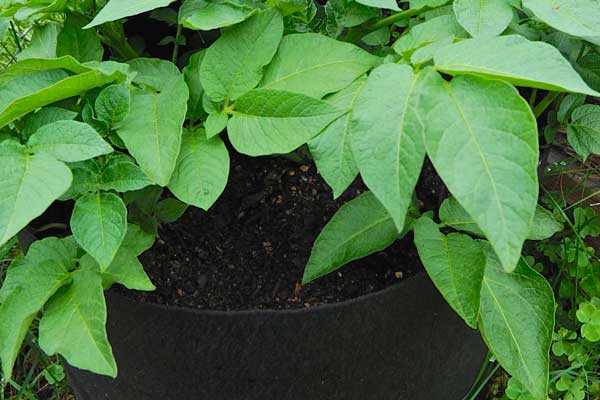
Many would-be vegetable gardeners are thwarted by a lack of space, impenetrable rocky soil or clay, or a shortage of sunshine. Alternative growing containers are the latest trend, making vegetable gardening easier than ever, even for those who have been limited in the past. Patio gardens and garden container alternatives can be grown with just 5 or 6 hours of sun each day. Don’t forget about vertical spaces, too. Hanging baskets can be used for lightweight greens and herbs and some fruits or vegetables will even grow in upside-down hanging planters. Check out some of the more popular options here.

